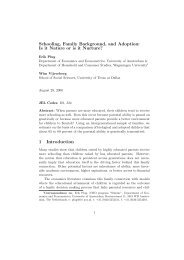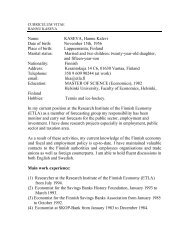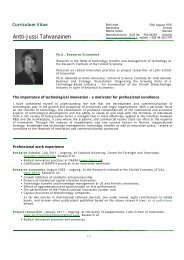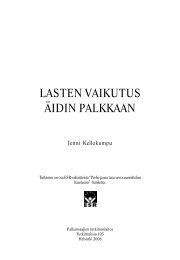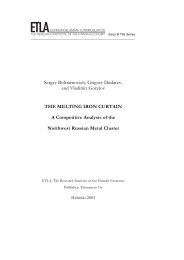20 general, arises from the requirements of the operating environment as well as the characteristics of the product or service developed. However, the need for functional integration and thus the pressure for co‐location varies from company to company, depending on a number of factors discussed in this article. This has been the first step in laying the foundation for rigorous theory‐driven empirical study of co‐location. The next step would be to craft a measurement instrument explicitly directed at addressing the need for co‐location, actual degree of co‐location, environmental characteristics, product characteristics, as well as measures of performance, and examine the hypotheses presented in this article in more detail. The ultimate measure of performance is of course financial performance, but clearly more proximate measures are needed to examine the causal path from functional integration to financial performance. As a final note, although the interviews conducted as part of this study were exploratory, it is noteworthy to mention that the external drivers or ”locational pulls” were rarely mentioned when the interviewees described the location decisions of R&D and manufacturing in their own context. In the words of one interviewee: ”90% of it is about internal interdependencies and coordination issues, 10% location‐specific drivers”. While it would be foolish to suggest this figure as a universal truth, it is not at all foolish to submit it as an interesting hypothesis worthy of further theoretical and empirical scrutiny.
21 REFERENCES Adler, P. S. (1995). Interdepartmental interdependence and coordination: The case of the design/manufacturing interface. Organization Science, 6(2), 147‐167. Appold, S. J. (2005). Location patterns of US industrial research: Mimetic isomorphism and the emergence of geographic charisma. Regional Studies, 39(1), 17‐39. Audretsch, D. B., & Feldman, M. P. (1996). R&D spillovers and the geography of innovation and production. American Economic Review, 86(3), 630‐640. Blanc, H., & Sierra, C. (1999). The internationalization of R&D by multinationals: A trade‐off between external and internal proximity. Cambridge Journal of Economics, 23, 187‐206. Brush, T. H., Maritan, C. A., & Karnani, A. (1999). The plant location decision in multinational manufacturing firms: An empirical analysis of international business and manufacturing strategy perspectives. Production and Operations Management, 8(2), 109‐131. Clark, K. B., & Wheelwright, S. C. (1993). Managing New Product and Process Development. New York: Free Press. Ekholm, K., & Hakkala, K. (2006). Location of R&D and high‐tech production by vertically integrated multinationals. Economic Journal, forthcoming. Ferdows, K. (1989). Mapping international factory networks. In K. Ferdows (Ed.), Managing International Manufacturing (pp. 3‐21). Amsterdam: Elsevier Science Publishers. Govindarajan, V., & Gupta, A. K. (2001). The Quest for Global Dominance. San Francisco: Jossey‐Bass. Helpman, E. (2006). Trade, FDI, and the Organization of Firms. NBER Working Paper Series, National Bureau of Economic Research. Howells, J. (1990). The location and organization of research and development: New horizons. Research Policy, 19(2), 133‐146. Howells, J. R. (1995). Going global: The use of ICT networks in research and development. Research Policy, 24(2), 169‐184. Iansiti, M. (1998). Technology Integration. Boston: Harvard Business School Press. Intel. (2002). 10‐K form: filed with the Securities and Exchange Commission of the United States. Intel. (2005). 10‐K form: filed with the Securities and Exchange Commission of the United States. Ketokivi, M., & Castañer, X. (2004). Strategic planning as an integrative device. Administrative Science Quarterly, 49(3), 337‐365. Ketokivi, M., Schroeder, R. G., & Turkulainen, V. (2006). Operations management and contingency theory: A new look at an old theory. Paper presented at the Academy of Management Annual Meeting, Atlanta, GA. Kuemmerle, W. (1999). The drivers of foreign direct investment into research and development: An empirical investigation. Journal of International Business Studies, 30(1), 1‐12. Mariani, M. (2002). Next to production or to technological clusters? The economics and management of R&D location. Journal of Management and Governance, 6, 131‐152. Mueller, E., & Morgan, J. N. (1962). Location decisions of manufacturers. American Economic Review, 52(2), 204‐217. Nokia. (2005). 20‐F form: filed with the Securities and Exchange Commission of the United States. Pearce, R., & Singh, S. (1992). Globalizing Research and Development. London: Macmillan. Pisano, G. P. (1997). The Development Factory: Unlocking the Potential of Process Innovation. Boston, MA: Harvard Business School Press. Rafii, F. (1995). How important is physical collocation to product development success? Business Horizons, 38(1), 78‐84. Rugman, A. M., & Verbeke, A. (2001). Subsidiary‐specific advantages in multinational enterprises. Strategic Management Journal, 22(3), 237‐250.



